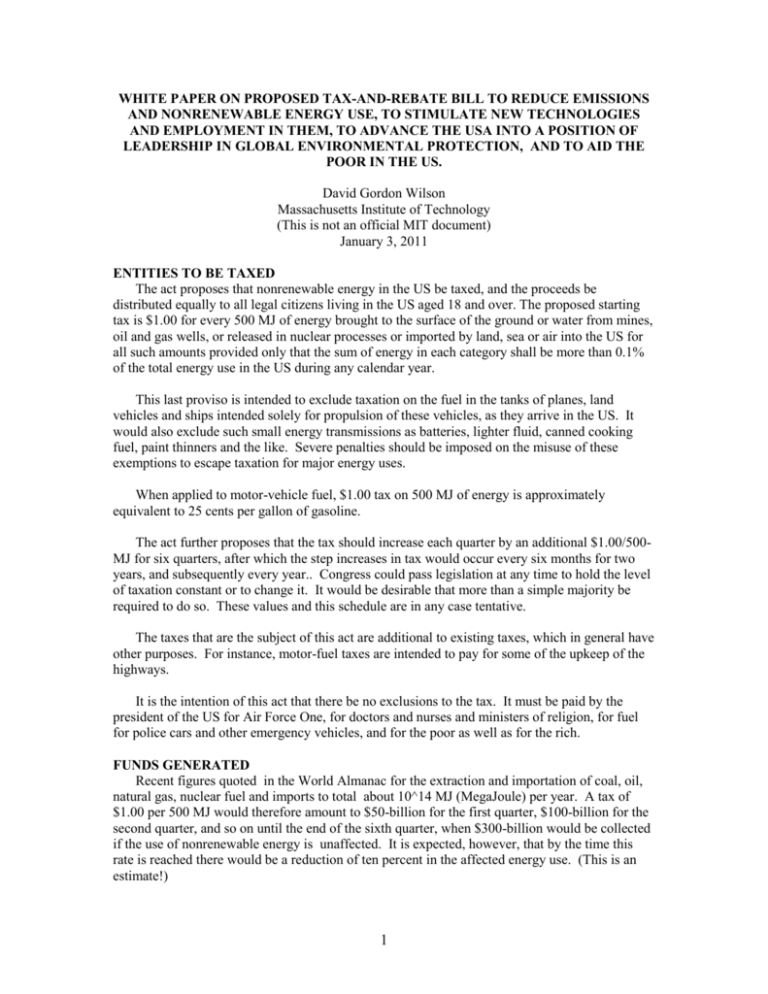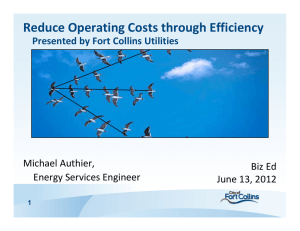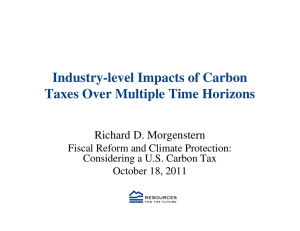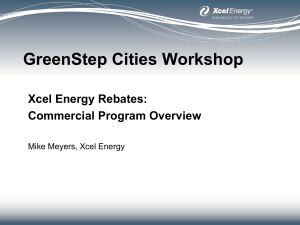DRAFT WHITE PAPER ON PROPOSED TAX-AND
advertisement

WHITE PAPER ON PROPOSED TAX-AND-REBATE BILL TO REDUCE EMISSIONS AND NONRENEWABLE ENERGY USE, TO STIMULATE NEW TECHNOLOGIES AND EMPLOYMENT IN THEM, TO ADVANCE THE USA INTO A POSITION OF LEADERSHIP IN GLOBAL ENVIRONMENTAL PROTECTION, AND TO AID THE POOR IN THE US. David Gordon Wilson Massachusetts Institute of Technology (This is not an official MIT document) January 3, 2011 ENTITIES TO BE TAXED The act proposes that nonrenewable energy in the US be taxed, and the proceeds be distributed equally to all legal citizens living in the US aged 18 and over. The proposed starting tax is $1.00 for every 500 MJ of energy brought to the surface of the ground or water from mines, oil and gas wells, or released in nuclear processes or imported by land, sea or air into the US for all such amounts provided only that the sum of energy in each category shall be more than 0.1% of the total energy use in the US during any calendar year. This last proviso is intended to exclude taxation on the fuel in the tanks of planes, land vehicles and ships intended solely for propulsion of these vehicles, as they arrive in the US. It would also exclude such small energy transmissions as batteries, lighter fluid, canned cooking fuel, paint thinners and the like. Severe penalties should be imposed on the misuse of these exemptions to escape taxation for major energy uses. When applied to motor-vehicle fuel, $1.00 tax on 500 MJ of energy is approximately equivalent to 25 cents per gallon of gasoline. The act further proposes that the tax should increase each quarter by an additional $1.00/500MJ for six quarters, after which the step increases in tax would occur every six months for two years, and subsequently every year.. Congress could pass legislation at any time to hold the level of taxation constant or to change it. It would be desirable that more than a simple majority be required to do so. These values and this schedule are in any case tentative. The taxes that are the subject of this act are additional to existing taxes, which in general have other purposes. For instance, motor-fuel taxes are intended to pay for some of the upkeep of the highways. It is the intention of this act that there be no exclusions to the tax. It must be paid by the president of the US for Air Force One, for doctors and nurses and ministers of religion, for fuel for police cars and other emergency vehicles, and for the poor as well as for the rich. FUNDS GENERATED Recent figures quoted in the World Almanac for the extraction and importation of coal, oil, natural gas, nuclear fuel and imports to total about 10^14 MJ (MegaJoule) per year. A tax of $1.00 per 500 MJ would therefore amount to $50-billion for the first quarter, $100-billion for the second quarter, and so on until the end of the sixth quarter, when $300-billion would be collected if the use of nonrenewable energy is unaffected. It is expected, however, that by the time this rate is reached there would be a reduction of ten percent in the affected energy use. (This is an estimate!) 1 COST TO THE GOVERNMENT OF SUCH TAXATION The proposed act requires that oil, gas, pipeline, shipping, coal and nuclear companies report their energy flows each month and transmit the tax amounts directly to an Energy Trust Fund set up by the Department of the Treasury. The cost to the government of revenue collection should, therefore, be negligible. Severe penalties should be put into law for infractions. Suggested fines are of one-thousand times the taxes that were fraudulently unpaid, plus jail sentences on the people principally involved and on their superiors of six months for the first offense, two years for the second offense, and five years for the third offense. The Department of the Treasury would need to set up a service bureau of, it is suggested, one-hundred professionals and 100 support personnel who would respond to questions about the law, and who would make periodic inspections of the reporting entities and of those for which there are reasonable grounds of suspicion that they should be reporting but are not doing so. This bureau should have a budget large enough to allow the hiring of consultants and consulting companies that could carry out “high-tech” inspections and tests. The annual budget for this service and inspection bureau is tentatively proposed to be $40 million. The act calls for all collected funds to be distributed equally to all legal US citizens of 18 or over at least once each quarter. The lowest-cost method of distribution would be to require every legal citizen in the age range to have a bank account. The banking industry would be delighted to have new customers with guaranteed monthly incomes. It is reckoned below that there are about 225-million legal citizens of 18 or over in the US. There will be some people, such as the homeless, who might not be eligible for bank accounts, and whose rebates should be handled by welfare agencies. There is a large prison population: it is recommended that rebates for inmates should be held in escrow, earning interest, until the release dates for each person. The amounts available upon release should provide a launch for each person to accomplish a transition to society, perhaps to buy a home, start a business etc. However, if an inmate has dependents her/his rebates should be made payable, in whole or in part, to them. Some form of arbitration should be set up to determine the proportion of an inmate's rebates that should be retained for her/his use upon release, and what proportion should go to which dependents, for those cases where there is disagreement between the inmate and her/his dependents. It is suggested that legal US citizens living abroad for more than ten months in any year should not receive rebates. They will not be paying the added taxes or fees on US purchases. They will be paying taxes on energy etc. in the places where they are living, and will be receiving rebates in the form of health care and the like. It is estimated that during the first year of the program the total cost of the distribution of the rebates, including the distributions to the homeless and to prison inmates and their dependents, would be $250-million, mainly in transition costs. Subsequently the costs should be $25-million per year. COSTS TO THE ENERGY PRODUCERS AND IMPORTERS Each company will already have records of its production, shipments etc. so that no additional costs will be involved. The costs involved with transferring funds to the Department of the Treasury will also be negligible. The actual funds transmitted will be considerable to start with and will increase over time. All these costs can be passed on to the consumers so that on paper, no additional costs will be incurred. 2 However, it is likely (and it is so intended) that there will be growing consumer resistance to the increased costs of nonrenewable fuels as consumers find ways of cutting back on their use, substituting renewable energy, conserving, buying more-economical vehicles and home-hearing and air-conditioning systems, and so forth. It is expected, therefore, that energy companies will not be able to pass through all their taxes, and that therefore the taxes will result in costs to them. These companies will have strong incentives to promote energy efficiency and to improve the viability and use of renewable fuels. CIITIZENS AFFECTED The act calls for the collected funds to be distributed to all legal US residents of 17 or over. The World Almanac quotes a figure of 75% of the population for this category. Therefore if the current US population is 300-million, the number receiving rebates would be 225-million. During the first quarter, therefore, each legal adult citizen would receive $74 each month, and $148 during the second quarter as the tax rate was doubled, and so on until the sixth quarter, when the amount would be around $375 per month. This figure is lower than six times the initial rebate because the usage of nonrenewable energy would have fallen. NON-CITIZENS People living in the US who are not citizens would receive no rebates. However, an intermediate category is of green-card holders, who could be described as aliens who have permission to work in the US. On that basis they should be included in the rebate. Whether they should receive all the financial benefits of citizenship is a question open to discussion.. COSTS OF ACCREDITATION There has always been an active underworld forging US passports and birth certificates, and this act will increase the demand for illegal documents. The penalties for such activities and for the use of forged and false documents should be increased, and more efforts should be devoted to detection, arrest and punishment of such criminals. A proposed budget for this additional enforcement work is $100-million per year. EVALUATION OF THE COST-OF-LIVING INDEX (INFLATION) The act requires that the formulation of the cost-of-living index be changed to include the rebates paid to legal adult citizens. This change would amount to the equivalent of one line in a computer program, so that the cost to the government would be negligible. It is, however, a very significant step. Without it, the present method of calculating inflation would indicate a steep rise, even though people were also receiving rebates often in excess of the increased costs to them. Pensioners and others whose pay is tied to the cost of living would receive more funds, which would constitute a heavy and totally unjustified load on government funds. EFFECT ON THE COSTS OF OTHER GOVERNMENT PROGRAMS Many programs presently funded by the government could be shut down once this tax-plusrebate scheme is underway. All funded programs aimed at arriving at improved efficiencies in automobiles, appliances and the like would be found to be unnecessary, because the incentives introduced by this act would work faster and better. After a period it would be found that fewer welfare programs would be needed because even the poorest person would now have a considerable income. All these effects need to be quantified, even in an approximate manner. 3 FUTURE POSSIBLE EXTENSIONS OF THE SYSTEM There is increasing evidence that the cap-and-trade system of reducing pollution has actually rewarded many polluters, and is in general not working well. It is believed that it would be better to make charges per kilogram of pollutant emissions to the air, water and soil. Such charges or taxes should, like those on nonrenewable energy, start at a low level and be increased in steps until they are strong enough to bring about major reductions in emissions. These charges should also be deposited into the trust fund and distributed in equal amounts to all legal US residents of eighteen or above. The government and industry costs of measuring emissions and charging for emissions taxes are not estimated here. David Gordon Wilson MIT room 3-256 77 Massachusetts Avenue CAMBRIDGE MA 02139-4307, USA E-mail: dgwilson@mit.edu 4









